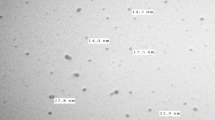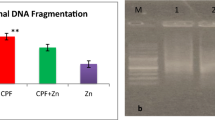Abstract
Environmental toxicants are chemical substances that remain in the environment owing to various activities such as manufacturing, product leaching, and human contamination which may result in adverse health effects. In this study, we investigated the effects of potassium bromate (KBrO3) and thymoquinone (TQ), on reproductive hormone levels and histomorphological variations in the ovaries and uteri of female mice. In the current study, all experimental animals were orally administered KBrO3 (100 mg/kg body weight) and TQ (20 mg/kg body weight) for 60 days. Alterations in hormone and antioxidative parameters along with histomorphological variations were assessed in mice. The findings demonstrated that the oral administration of KBrO3 had a significant effect on body weight, uterine weight, and gonadosomatic index (GSI), along with changes in gonadotropin, estrogen, and progesterone levels in female mice. Specifically, KBrO3 degenerated the thecal layer around follicles and caused vacuolization. KBrO3 decreased the number of growing follicles and increased the number of mature follicles. TQ administration restored normal ovarian histoarchitecture. TQ protected female mice against reproductive toxicity induced by KBrO3. Our findings suggest that TQ can be used as a natural therapeutic agent to combat KBrO3-induced reproductive toxicity by improving the hormonal and histomorphological parameters. Our study implies that TQ can be used as natural therapeutic medicine against the reprotoxic effect caused by KBrO3 by improving hormonal and histomorphological parameters.







Similar content being viewed by others
Data availability
The data used to support the findings of this study are included within the article.
References
Abdel-Daim MM, Sayed AA, Abdeen A, Aleya L, Ali D, Alkahtane AA, Alarifi S, Alkahtani S (2019) Piperine enhances the antioxidant and anti-inflammatory activities of thymoquinone against microcystin-LR-induced hepatotoxicity and neurotoxicity in mice. Oxidat Med Cel Longev e1309175. https://doi.org/10.1155/2019/1309175.
Ahmad MK, Amani S, Mahmood R (2014) Potassium bromate causes cell lysis and induces oxidative stress in human erythrocytes. Environ Toxicol 29(2):138–145. https://doi.org/10.1002/tox.20780
Ahmad MK, Mahmood R (2016) Protective effect of taurine against potassium bromate-induced hemoglobin oxidation, oxidative stress, and impairment of antioxidant defense system in blood. Environ Toxicol 31(3):304–313. https://doi.org/10.1002/tox.22045
Akgül B, Aycan İÖ, Hidişoğlu E, Afşar E, Yıldırım S, Tanrıöver G, Coşkunfırat N, Sanlı S, Aslan M (2021) Alleviation of prilocaine-induced epileptiform activity and cardiotoxicity by thymoquinone. Daru: Journal of Faculty of Pharmacy, Tehran University of Medical Sciences 29(1):85–99. https://doi.org/10.1007/s40199-020-00385-2.
Aboud Al, Daifullah RS, Baty KF, Alsharif KE, Hassan AS, Zhery OA, Habotta EK, Elmahallawy HK, Amin AE, Moneim A, Kassab RB (2021) Protective efficacy of thymoquinone or ebselen separately against arsenic-induced hepatotoxicity in rat. Environ Sci Pollut Res 28(5):6195–6206. https://doi.org/10.1007/s11356-020-10955-1
Ali BH, Blunden G (2003) Pharmacological and toxicological properties of Nigella sativa. Phytotherapy Research: PTR 17(4):299–305. https://doi.org/10.1002/ptr.1309
Altoom NG, Ajarem J, Allam AA, Maodaa SN, Abdel-Maksoud MA (2018) Deleterious effects of potassium bromate administration on renal and hepatic tissues of swiss mice. Saudi Journal of Biological Sciences 25(2):278–284. https://doi.org/10.1016/j.sjbs.2017.01.060
Aycan IÖ, Tüfek A, Tokgöz O, Evliyaoğlu O, Fırat U, Kavak GÖ, Turgut H, Yüksel MU (2014) Thymoquinone treatment against acetaminophen-induced hepatotoxicity in rats. International Journal of Surgery (london, England) 12(3):213–218. https://doi.org/10.1016/j.ijsu.2013.12.013
Bagur AC, Mautalen CA (1992) Risk for developing osteoporosis in untreated premature menopause. Calcif Tissue Int 51(1):4–7. https://doi.org/10.1007/BF00296207
Baraskar K, Thakur P, Shrivastava R, Shrivastava VK (2021) Female obesity: association with endocrine disruption and reproductive dysfunction. Obes Med 28:100375. https://doi.org/10.1016/j.obmed.2021.100375.
Bayomy NA, Soliman GM, Abdelaziz EZ (2016) Effect of potassium bromate on the liver of adult male albino rat and a possible protective role of vitamin C: histological, immunohistochemical, and biochemical study. Anat Rec 299(9):1256–1269. https://doi.org/10.1002/ar.23386
Buhling KJ, Grajecki D (2013) The effect of micronutrient supplements on female fertility. Curr Opin Obstet Gynecol 25(3):173–180. https://doi.org/10.1097/GCO.0b013e3283609138
Chipman JK, Davies JE, Parsons JL, Nair J, O’Neill G, Fawell JK (1998) DNA oxidation by potassium bromate; a direct mechanism or linked to lipid peroxidation? Toxicology 126(2):93–102. https://doi.org/10.1016/s0300-483x(97)00174-1
Collins AJ, Lewis DA (1971) Lysosomal enzyme levels in the blood of arthritic rats. Biochem Pharmacol 20(1):251–253. https://doi.org/10.1016/0006-2952(71)90496-5
Craig ZR, Wang W, Flaws JA (2011) Endocrine-disrupting chemicals in ovarian function: effects on steroidogenesis, metabolism and nuclear receptor signaling. Reproduction (cambridge, England) 142(5):633–646. https://doi.org/10.1530/REP-11-0136
Diamanti-Kandarakis E, Bourguignon J-P, Giudice LC, Hauser R, Prins GS, Soto AM, Thomas Zoeller R, Gore AC (2009) Endocrine-disrupting chemicals: an endocrine society scientific statement. Endocr Rev 30(4):293–342. https://doi.org/10.1210/er.2009-0002
Elsheikh AS, Fadul TF, Aboagla EM, Gameel AA (2016) Effects of potassium bromate on male rat growth and testicular histology. Asian Pacific J Reproduc 5. https://doi.org/10.1016/j.apjr.2016.07.001.
Farkhondeh T, Samarghandian S, Shahri AMP, Samini F (2018) The neuroprotective effects of thymoquinone: a review. Dose-Response 16(2):1559325818761455. https://doi.org/10.1177/1559325818761455
Fisher J, Bull RJ (2006) Development of a rat dosimetry model for bromate. Toxicology 221(2–3):235–240. https://doi.org/10.1016/j.tox.2006.01.022
Goyal SN, Prajapati CP, Gore PR, Patil CR, Mahajan UB, Sharma C, Talla SP, Ojha SK (2017) Therapeutic potential and pharmaceutical development of thymoquinone: a multitargeted molecule of natural origin. Front Pharmacol 8:656. https://doi.org/10.3389/fphar.2017.00656
Guo L-P, Liu S-X, Yang Q, Hong-Yang Liu L-L, Hao Y-H, Zhang X-Q (2020) Effect of thymoquinone on acute kidney injury induced by sepsis in BALB/c mice. Biomed Res Int 2020:1594726. https://doi.org/10.1155/2020/1594726
Hidiroglou M (1979) Trace element deficiencies and fertility in ruminants: a review. J Dairy Sci 62(8):1195–1206. https://doi.org/10.3168/jds.S0022-0302(79)83400-1
Hu X, Liang Y, Zhao Bo, Wang Y (2019) Thymoquinone protects human retinal pigment epithelial cells against hydrogen peroxide induced oxidative stress and apoptosis. J Cell Biochem 120(3):4514–4522. https://doi.org/10.1002/jcb.27739
Ince S, Kucukkurt I, Demirel HH, Turkmen R, Sever E (2012) Thymoquinone attenuates cypermethrin induced oxidative stress in Swiss albino mice. Pestic Biochem Physiol 104(3):229–235. https://doi.org/10.1016/j.pestbp.2012.09.003
Khalifa AA, Rashad RM, El-Hadidy WF (2021) Thymoquinone protects against cardiac mitochondrial DNA loss, oxidative stress, inflammation and apoptosis in isoproterenol-induced myocardial infarction in rats. Heliyon 7(7):e07561. https://doi.org/10.1016/j.heliyon.2021.e07561.
Kobayashi N, Orisaka M, Cao M, Kotsuji F, Leader A, Sakuragi N, Tsang BK (2009) Growth differentiation factor-9 mediates follicle-stimulating hormone-thyroid hormone interaction in the regulation of rat preantral follicular development. Endocrinology 150(12):5566–5574. https://doi.org/10.1210/en.2009-0262
Kumari M, Singh P (2013) Study on the reproductive organs and fertility of the male mice following administration of metronidazole. International Journal of Fertility & Sterility 7(3):225–238
Landucci E, Mazzantini C, Buonvicino D, Pellegrini-Giampietro DE, Bergonzi MC (2021) Neuroprotective effects of thymoquinone by the modulation of ER stress and apoptotic pathway in in vitro model of excitotoxicity. Molecules (basel, Switzerland) 26(6):1592. https://doi.org/10.3390/molecules26061592
Li J, Asaduzzaman Khan Md, Wei C, Cheng J, Chen H, Yang L, Ijaz I, Junjiang Fu (2017) Thymoquinone inhibits the migration and invasive characteristics of cervical cancer cells SiHa and CaSki in vitro by targeting epithelial to mesenchymal transition associated transcription factors Twist1 and Zeb1. Molecules : A Journal of Synthetic Chemistry and Natural Product Chemistry 22(12):2105. https://doi.org/10.3390/molecules22122105
Liguori I, Russo G, Curcio F, Bulli G, Aran L, Della-Morte D, Gargiulo G et al (2018) Oxidative stress, aging, and diseases. Clin Interv Aging 13:757–772. https://doi.org/10.2147/CIA.S158513
Lillie, Ralph Dougall, and Harold M. Fullmer. 1976. Histopathologic technic and practical histochemistry. McGraw-Hill.
Magoffin DA (2005) Ovarian theca cell. Int J Biochem Cell Biol 37(7):1344–1349. https://doi.org/10.1016/j.biocel.2005.01.016
Mansour MA, Nagi MN, El-Khatib AS, Al-Bekairi AM (2002) Effects of thymoquinone on antioxidant enzyme activities, lipid peroxidation and DT-diaphorase in different tissues of mice: a possible mechanism of action. Cell Biochem Funct 20(2):143–151. https://doi.org/10.1002/cbf.968
Mascarenhas MN, Flaxman SR, Boerma T, Vanderpoel S, Stevens GA (2012) National, regional, and global trends in infertility prevalence since 1990: a systematic analysis of 277 health surveys. PLoS Medicine 9(12):e1001356. https://doi.org/10.1371/journal.pmed.1001356.
Mathews DM, Johnson NP, Sim RG, O’Sullivan S, Peart JM, Hofman PL (2021) Iodine and fertility: do we know enough? Hum Reprod 36(2):265–274. https://doi.org/10.1093/humrep/deaa312
McDorman KS, Pachkowski BF, Nakamura J, Wolf DC, Swenberg JA (2005) Oxidative DNA damage from potassium bromate exposure in long-evans rats is not enhanced by a mixture of drinking water disinfection by-products. Chem Biol Interact 152(2–3):107–117. https://doi.org/10.1016/j.cbi.2005.02.003
Nwonuma CO, Irokanulo EO, Iji CE, Alejolowo OO, Adetunji CO (2016) Effect of Thaumatococcus Daniellii leaf rat-feed on potassium bromate induced testicular toxicity. Asian Pacific Journal of Reproduction 5(6):500–505. https://doi.org/10.1016/j.apjr.2016.10.014
Oloyede OB, Sunmonu TO (2009) Potassium bromate content of selected bread samples in Ilorin, Central Nigeria and its effect on some enzymes of rat liver and kidney. Food Chem Toxicol 47(8):2067–2070. https://doi.org/10.1016/j.fct.2009.05.026
Patel SA, Zhou C, Rattan S, Flaws J (2015) Effects of endocrine-disrupting chemicals on the ovary1. In Biology of Reproduction 93(1):1–9. https://doi.org/10.1095/biolreprod.115.130336
Peters AE, Mihalas BP, Bromfield EG, Roman SD, Nixon B, Sutherland JM (2020) Autophagy in female fertility: a role in oxidative stress and aging. Antioxid Redox Signal 32(8):550–568. https://doi.org/10.1089/ars.2019.7986
Ranjbar S, Larijani B (2014) Medicinal plants as potential new target drugs in endocrine disorders- review article. Iran J Public Health 43(March):24–34
Rizzo A, Roscino MT, Binetti F, Sciorsci RL (2012) Roles of reactive oxygen species in female reproduction. Reproduction in Domestic Animals = Zuchthygiene 47(2):344–52. https://doi.org/10.1111/j.1439-0531.2011.01891.x.
Sendak RA, Kuber Sampath T, McPherson JM (2007) Newly reported roles of thyroid-stimulating hormone and follicle-stimulating hormone in bone remodelling. Int Orthop 31(6):753–757. https://doi.org/10.1007/s00264-007-0417-7
Shanmugavel V, Santhi KK, Kurup AH, Kalakandan S, Anandharaj A, Rawson A (2020) Potassium bromate: effects on bread components, health, environment and method of analysis: a review. Food Chemistry 311:125964. https://doi.org/10.1016/j.foodchem.2019.125964.
Shaterzadeh-Yazdi H, Noorbakhsh M-F, Hayati F, Samarghandian S, Farkhondeh T (2018) Immunomodulatory and anti-inflammatory effects of thymoquinone. Cardiovasc Hematol Disord: Drug Targets 18(1):52–60. https://doi.org/10.2174/1871529X18666180212114816
Smyth PPA (2003) Role of iodine in antioxidant defence in thyroid and breast disease. BioFactors (oxford, England) 19(3–4):121–130. https://doi.org/10.1002/biof.5520190304
Stocco C, Telleria C, Gibori G (2007) The molecular control of corpus luteum formation, function, and regression. Endocr Rev 28(1):117–149. https://doi.org/10.1210/er.2006-0022
Thakur P, Shrivastava S, Shrivastava R, Shrivastava VK (2018) Impairment of ovarian biochemical contents and enzymes activities during potassium bromate (KBRO 3 - ) intoxication in albino mice mus musculus
Vobecký M, Babický A (1994) Effect of enhanced bromide intake on the concentration ratio I/Br in the rat thyroid gland. Biol Trace Elem Res 43–45:509–516. https://doi.org/10.1007/BF02917354
Vobecký M, Babický A, Lener J, Svandová E (1996) Interaction of bromine with iodine in the rat thyroid gland at enhanced bromide intake. Biol Trace Elem Res 54(3):207–212. https://doi.org/10.1007/BF02784432
Winters BR, Walsh TJ (2014) The epidemiology of male infertility. Urol Clinics N Am 41(1):195–204. https://doi.org/10.1016/j.ucl.2013.08.006
World Health Organization (2016) Evaluation of certain food additives and contaminants. Eightieth report of the joint FAO/WHO expert committee on food additives. World Health Organization Technical Report Series 995:1–114, back cover
Yamada K, Hiradate Y, Goto M, Nishiyama C, Hara K, Yoshida H, Tanemura K (2018) Potassium bromate disrupts mitochondrial distribution within murine oocytes during in vitro maturation. Reproductive Medicine and Biology 17(2):143–148. https://doi.org/10.1002/rmb2.12079
Yi T, Cho S-G, Yi Z, Pang X, Rodriguez M, Wang Y, Sethi G, Aggarwal BB, Liu M (2008) Thymoquinone inhibits tumor angiogenesis and tumor growth through suppressing AKT and ERK signaling pathways. Mol Cancer Ther 7(7):1789–1796. https://doi.org/10.1158/1535-7163.MCT-08-0124
Zhang J, Yigang Bao Xu, Zhou, and Lianwen Zheng. (2019) Polycystic ovary syndrome and mitochondrial dysfunction. Reproductive Biology and Endocrinology : RB&E 17(August):67. https://doi.org/10.1186/s12958-019-0509-4
Author information
Authors and Affiliations
Corresponding author
Ethics declarations
Funding
This research was supported by the Department of Bioscience Barkatullah University, Bhopal, Madhya Pradesh, India.
Conflict of interest
The authors declare no competing interests.
Ethical approval
The experimental work was performed with the approval of CPCSEA, an institutional ethical committee(IAEC), and CPCSEA (Ref. No.1885/GOI/S/16/CPCSEA/IAEC/BU/23).
Informed consent
For this type of study informed consent is not required.
Consent for publication
Yes.
Additional information
Publisher's Note
Springer Nature remains neutral with regard to jurisdictional claims in published maps and institutional affiliations.
Rights and permissions
Springer Nature or its licensor (e.g. a society or other partner) holds exclusive rights to this article under a publishing agreement with the author(s) or other rightsholder(s); author self-archiving of the accepted manuscript version of this article is solely governed by the terms of such publishing agreement and applicable law.
About this article
Cite this article
Patel, N., Shrivastava, R. & Shrivastava, V.K. Ameliorative role of thymoquinone against reprotoxic effect caused by potassium bromate in female mice. Comp Clin Pathol 32, 467–475 (2023). https://doi.org/10.1007/s00580-023-03458-1
Received:
Accepted:
Published:
Issue Date:
DOI: https://doi.org/10.1007/s00580-023-03458-1




